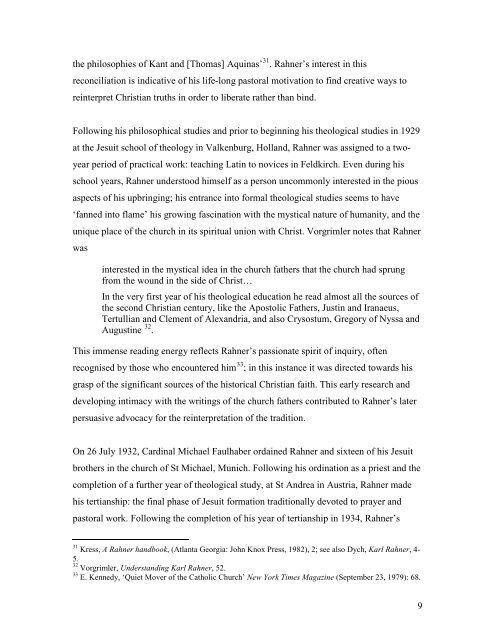Introductory notes for readers of this thesis - Theses - Flinders ...
Introductory notes for readers of this thesis - Theses - Flinders ...
Introductory notes for readers of this thesis - Theses - Flinders ...
You also want an ePaper? Increase the reach of your titles
YUMPU automatically turns print PDFs into web optimized ePapers that Google loves.
the philosophies <strong>of</strong> Kant and [Thomas] Aquinas’ 31 . Rahner’s interest in <strong>this</strong>reconciliation is indicative <strong>of</strong> his life-long pastoral motivation to find creative ways toreinterpret Christian truths in order to liberate rather than bind.Following his philosophical studies and prior to beginning his theological studies in 1929at the Jesuit school <strong>of</strong> theology in Valkenburg, Holland, Rahner was assigned to a twoyearperiod <strong>of</strong> practical work: teaching Latin to novices in Feldkirch. Even during hisschool years, Rahner understood himself as a person uncommonly interested in the piousaspects <strong>of</strong> his upbringing; his entrance into <strong>for</strong>mal theological studies seems to have‘fanned into flame’ his growing fascination with the mystical nature <strong>of</strong> humanity, and theunique place <strong>of</strong> the church in its spiritual union with Christ. Vorgrimler <strong>notes</strong> that Rahnerwasinterested in the mystical idea in the church fathers that the church had sprungfrom the wound in the side <strong>of</strong> Christ…In the very first year <strong>of</strong> his theological education he read almost all the sources <strong>of</strong>the second Christian century, like the Apostolic Fathers, Justin and Iranaeus,Tertullian and Clement <strong>of</strong> Alexandria, and also Crysostum, Gregory <strong>of</strong> Nyssa andAugustine 32 .This immense reading energy reflects Rahner’s passionate spirit <strong>of</strong> inquiry, <strong>of</strong>tenrecognised by those who encountered him33 ; in <strong>this</strong> instance it was directed towards hisgrasp <strong>of</strong> the significant sources <strong>of</strong> the historical Christian faith. This early research anddeveloping intimacy with the writings <strong>of</strong> the church fathers contributed to Rahner’s laterpersuasive advocacy <strong>for</strong> the reinterpretation <strong>of</strong> the tradition.On 26 July 1932, Cardinal Michael Faulhaber ordained Rahner and sixteen <strong>of</strong> his Jesuitbrothers in the church <strong>of</strong> St Michael, Munich. Following his ordination as a priest and thecompletion <strong>of</strong> a further year <strong>of</strong> theological study, at St Andrea in Austria, Rahner madehis tertianship: the final phase <strong>of</strong> Jesuit <strong>for</strong>mation traditionally devoted to prayer andpastoral work. Following the completion <strong>of</strong> his year <strong>of</strong> tertianship in 1934, Rahner’s31 Kress, A Rahner handbook, (Atlanta Georgia: John Knox Press, 1982), 2; see also Dych, Karl Rahner, 4-5.32 Vorgrimler, Understanding Karl Rahner, 52.33 E. Kennedy, ‘Quiet Mover <strong>of</strong> the Catholic Church’ New York Times Magazine (September 23, 1979): 68.9















